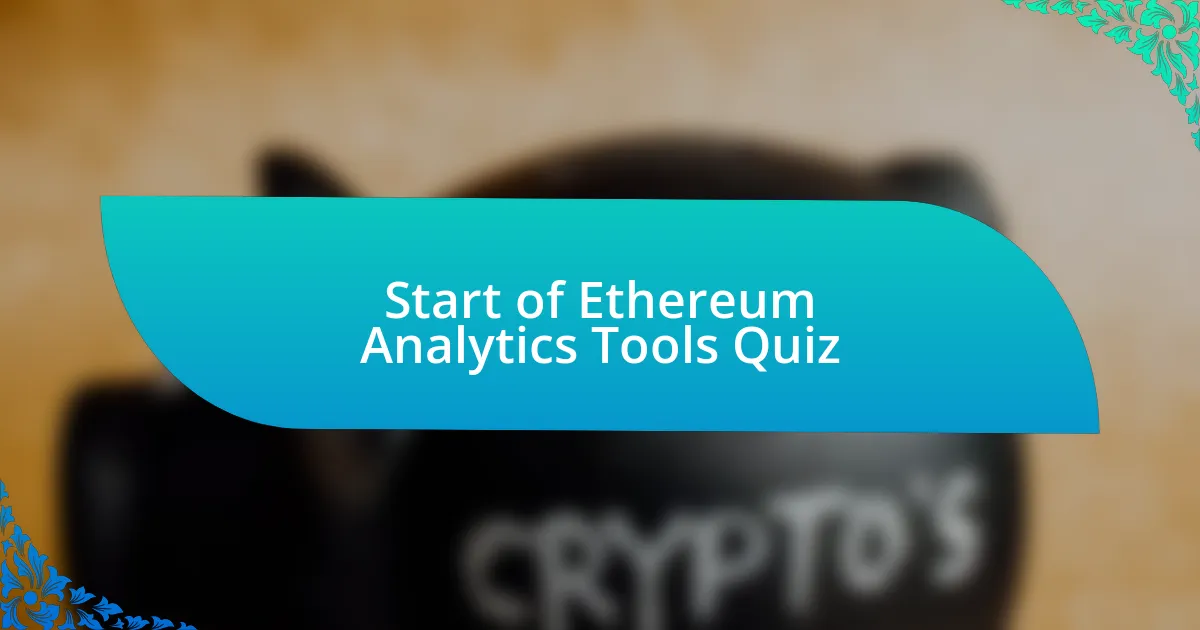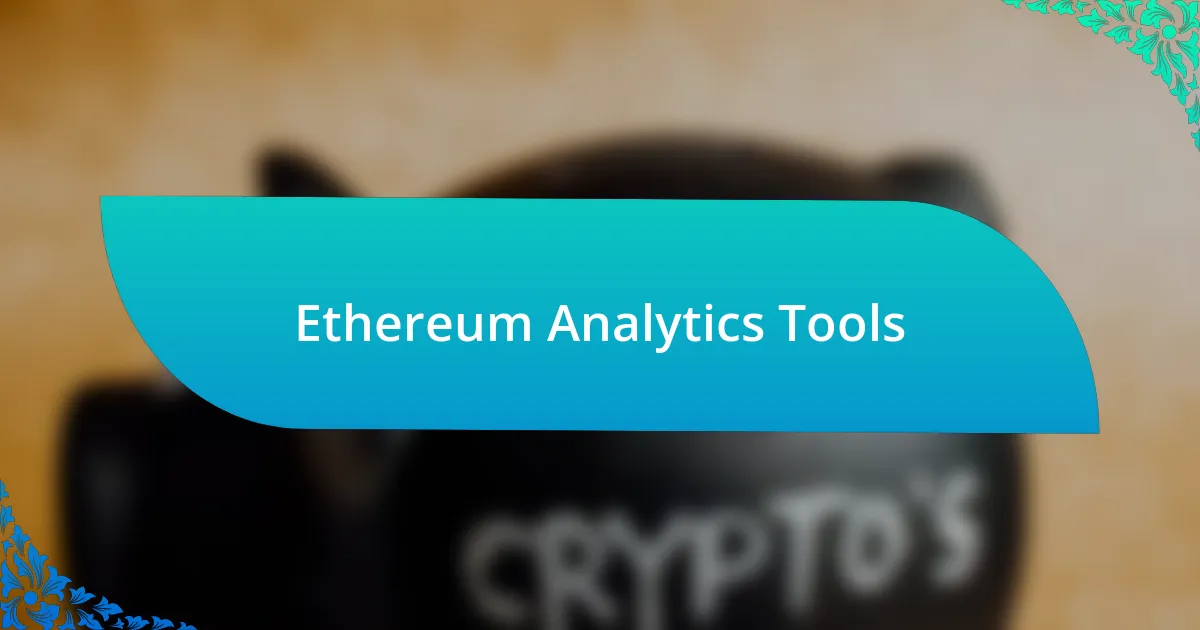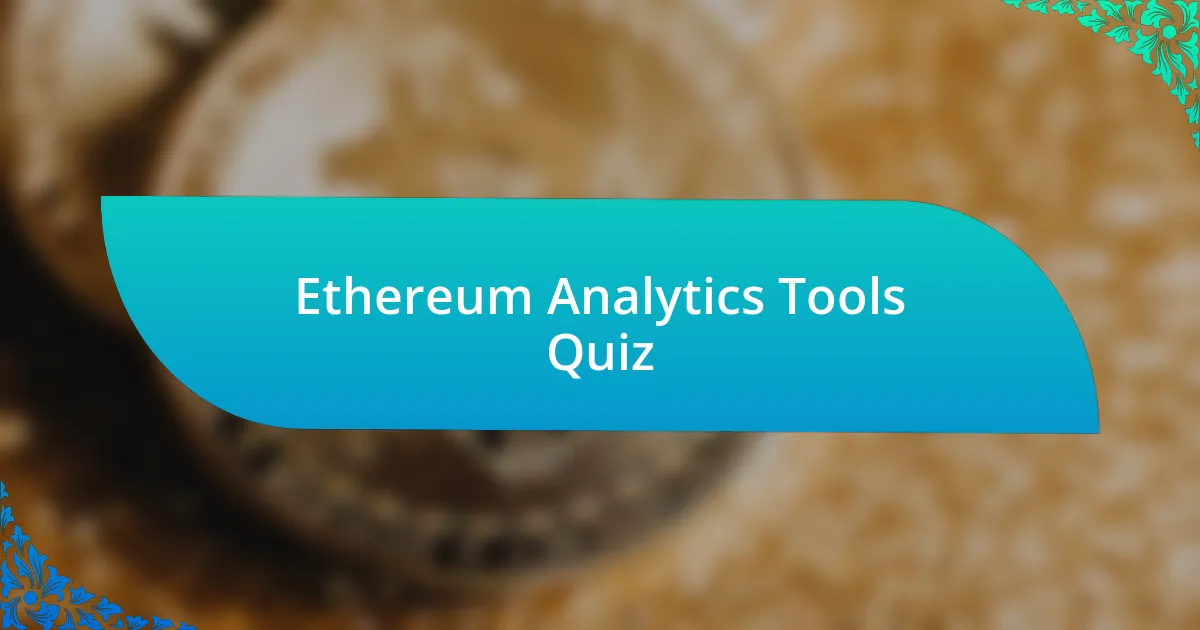
Start of Ethereum Analytics Tools Quiz
1. What is MetaMask used for exactly?
- A chat application for messaging other users.
- A wallet for storing physical currencies securely.
- A platform for trading cryptocurrency assets directly.
- A browser plugin that connects to Infura to mainly show your account balance.
2. Which is the right order for denominations on the Ethereum Blockchain?
- Ether, Finney, Szabo, Gwei.
- Szabo, Gwei, Ether, Finney.
- Gwei, Szabo, Finney, Ether.
- Finney, Gwei, Ether, Szabo.
3. What is the nonce field used for in a transaction?
- It’s a boolean field to signify transaction success.
- It’s a datetime field for transaction timestamps.
- It’s a text field for user comments.
- It’s a numerical field to protect against replay attacks.
4. In Solidity, if you divide integer -5 by integer 2, the result is?
- -4
- -3
- -2
- 2
5. How long is an Ethereum address compared to public and private keys?
- 64 characters long
- 32 decimal digits
- 40 hexadecimal characters
- 12 binary digits
6. What is CryptoSlam used for?
- An aggregator of non-fungible tokens (NFTs).
- A wallet for storing cryptocurrency securely.
- A platform for creating and selling digital art.
- A decentralized exchange for cryptocurrency trading.
7. What does DappLooker do?
- A platform for buying and selling non-fungible tokens (NFTs).
- A software for trading cryptocurrencies with automated strategies.
- A wallet service for storing various cryptocurrencies securely.
- A no-code multi-chain blockchain analytics and visualization platform.
8. What does Nefertiti do?
- A historical figure known for building pyramids.
- A legendary warrior in ancient Egyptian mythology.
- A goddess associated with love and beauty in Egyptian lore.
- An AI-powered NFT data solution for investors, analysts, and businesses.
9. What does Boto.io do?
- A no-code automation platform for web3, automating notifications and on-chain activities.
- A platform for creating decentralized applications with code.
- A wallet service for storing NFTs and digital assets.
- A decentralized exchange for trading cryptocurrencies.
10. What does SnowGenesis provide insights on?
- A marketplace for buying and selling cryptocurrencies.
- The insights layer for NFT financialization.
- A tool for creating and minting NFTs.
- A gaming platform for blockchain-based games.
11. What does NFT Price Floor enable you to do?
- Allows you to create new NFTs for free.
- Enables you to discover, track, and trade all the NFT markets in one place.
- Records NFT ownership on the Bitcoin blockchain.
- Restricts trading to specific NFT platforms only.
12. What function does flooredApe serve?
- Brings community, attention, and data into one wallet tool.
- Connects different blockchains for asset transfers.
- Serves as a security tool for private keys.
- Automates trading strategies for cryptocurrencies.
13. How does Bello help creators?
- Stores blockchain data for future reference by creators.
- Collects data about creators’ activities on blockchains.
- Transforms blockchain data into actionable insights for creators.
- Displays blockchain data for creators to view.
14. What is Wagmi Labs known for?
- A cryptocurrency wallet for storing coins.
- A decentralized exchange for token swaps.
- A platform for creating Ethereum smart contracts.
- An all-in-one platform for trading NFTs.
15. What service does Oraqle provide?
- Develops traditional banking software.
- Grants cloud storage services for individuals.
- Provides systematic NFT investing.
- Offers social media marketing solutions.
16. What does APY.Vision offer to users?
- An all-in-one analytics dashboard for liquidity providers and yield farmers.
- A platform for buying and selling cryptocurrencies.
- A tool for tracking stock market prices.
- A wallet for storing digital assets.
17. What kind of reports can Bloxy generate?
- Reports focusing solely on NFT artwork pricing trends.
- Reports based on blockchain real-time data, including DEX trades analysis and DEX arbitrage analysis.
- Reports analyzing traditional stock market performance metrics.
- Reports limited to cryptocurrency exchange rates and volatility.
18. What does DeBank track?
- Analyzes centralized exchange performance and fees.
- Monitors NFT trading volumes and prices.
- Tracks your DeFi portfolio with data and analytics.
- Collects news about blockchain technology and trends.
19. What kind of data does DeepDAO organize?
- Visualizes social media trends related to finance.
- Collects and organizes quantitative and qualitative data about DAOs.
- Tracks price fluctuations of various altcoins.
- Provides real-time trading data for cryptocurrencies.
20. What type of dashboard does DefiLlama offer?
- A single-chain yield tracker for cryptocurrencies.
- An NFT marketplace focused on digital art.
- A decentralized exchange for trading tokens.
- A multi-chain TVL stats dashboard with data connectors contributed and maintained by a community.
21. What functionality does Dune Analytics provide?
- Offers a marketplace for buying and selling non-fungible tokens.
- Acts as a wallet for storing various cryptocurrencies and tokens.
- Provides a NFT showcasing platform for artists to display their work.
- Allows you to instantly create and share analysis of Ethereum data, converting smart contract data to human-readable format queryable with SQL.
22. What research focus does L2beat have?
- Tracks user adoption of Bitcoin wallets and exchanges.
- Analyzes macroeconomic impacts on cryptocurrency prices.
- Offers educational resources about traditional finance theories.
- Provides analytics and research about Ethereum layer 2 scaling, including in-depth comparisons of major protocols.
23. What is the primary function of Nansen?
- Combines on-chain data with a massive database containing millions of wallet labels for Ethereum analytics.
- A service for managing personal finances and budgeting.
- A software for creating and designing video games.
- A platform for trading traditional stocks and bonds.
24. What analytics does Revert Finance provide?
- Offers real-time news updates on blockchain technology.
- Analyzes stock market trends for cryptocurrency investments.
- Monitors social media sentiment for crypto projects.
- Provides actionable analytics for DeFi liquidity providers on Uniswap v2, v3, and Sushiswap.
25. What type of metrics does Token Terminal focus on?
- Offers real-time trading signals for daily investors.
- Provides traditional financial metrics on cryptoassets and DeFi products.
- Focuses on gaming statistics within blockchain platforms.
- Delivers social media sentiment analysis for tokens.
26. What insights can Unispark offer?
- Offers real-time trading signals for crypto assets and DeFi investments.
- Allows you to analyze, optimize, and simulate Uniswap V3 positions for useful insights on fees, returns, risk, volume, and impermanent loss.
- Functions as a social network for sharing NFT artworks and collaborations.
- Provides automated bot trading strategies for various cryptocurrencies.
27. What does vfat.tools serve as?
- A marketplace for trading cryptocurrencies and tokens.
- A wallet for storing non-fungible tokens (NFTs).
- A minimalist yield farming dashboard and farming calculator for popular farms and their APY.
- A platform for creating decentralized applications (dApps).
28. What does DeFi Market Cap monitor?
- Tracks key metrics of several DeFi protocols.
- Analyzes fiat currency trends in the market.
- Monitors blockchain transactions for Ethereum.
- Reports on NFT sales and auction outcomes.
29. What type of analysis can be done using DeFi Users Over Time?
- Tracks users overall and for several DeFi protocols using Dune Analytics.
- Analyzes fiat currency conversions across DeFi platforms.
- Measures the total market cap of all DeFi tokens over time.
- Evaluates transaction fees associated with DeFi trades.
30. What information does the REKT Database compile?
- A collection of crypto trading strategies and tips.
- A repository of blockchain programming tutorials.
- A database of 2,500+ DeFi scams, hacks, and exploits.
- A database of successful ICO projects and their earnings.

Quiz Completed Successfully!
Congratulations on finishing the quiz on Ethereum Analytics Tools! Your engagement with this topic has undoubtedly enhanced your understanding of the various tools available for analyzing Ethereum’s blockchain. You may now have a clearer perspective on how these tools function and the crucial role they play in the cryptocurrency ecosystem. Each question you answered contributed to building knowledge that can help you navigate the world of Ethereum more effectively.
Throughout this quiz, you likely gained insights into specific analytics platforms, their features, and how they aid in tracking and understanding Ethereum transactions. You might have learned about the importance of data visualization, transaction monitoring, and network analysis. This knowledge is not just theoretical; it has practical applications for investors, developers, and enthusiasts alike.
Now that you’ve completed the quiz, we invite you to explore the next section on this page about Ethereum Analytics Tools. There, you’ll find more in-depth resources that can further expand your understanding. Learning more about these tools will empower you to make informed decisions in your Ethereum journey. Happy exploring!

Ethereum Analytics Tools
Overview of Ethereum Analytics Tools
Ethereum analytics tools are platforms designed to analyze, visualize, and interpret data related to the Ethereum blockchain. They help users track transactions, monitor smart contract activity, and assess network health. These tools are essential for developers, investors, and researchers wanting to understand Ethereum’s ecosystem and its dynamics. Common features include transaction tracking, network statistics, and wallet analysis, providing insights into user behavior and market trends.
Key Features of Ethereum Analytics Tools
Key features of Ethereum analytics tools include on-chain data analysis, real-time transaction monitoring, and visual dashboards. Users can explore transaction history, view gas fees, and analyze contract interactions. Tools often provide alerts for significant blockchain events. Data aggregation and filtering capabilities help users focus on specific wallets or contracts, enabling detailed evaluations of blockchain activities and market conditions.
Popular Ethereum Analytics Tools
Popular Ethereum analytics tools include Etherscan, Dune Analytics, and Nansen. Etherscan is a block explorer that tracks transactions and contracts on the Ethereum network. Dune Analytics allows users to create custom queries and dashboards through SQL. Nansen combines blockchain data with wallet insights, offering analytical features specific to DeFi and NFT markets. Each tool serves different needs, catering to diverse user types in the Ethereum ecosystem.
Use Cases for Ethereum Analytics Tools
Ethereum analytics tools serve various use cases, including investment analysis, network monitoring, and research. Investors use these tools to assess the performance of tokens and identify trends. Developers monitor smart contract activities to ensure efficiency and security. Researchers analyze transaction patterns and user behavior for academic purposes. Each use case benefits from real-time data and historical context, enhancing decision-making processes.
Future Trends in Ethereum Analytics Tools
Future trends in Ethereum analytics tools may include enhanced AI-driven insights, improved user interfaces, and increased integration with DeFi platforms. As the Ethereum network evolves, tools will likely adapt to offer more predictive analytics and advanced metrics. The demand for deeper insights into user activities and market dynamics will drive innovation. These advancements will support users in maximizing their engagement and understanding of the Ethereum ecosystem.
What are Ethereum Analytics Tools?
Ethereum Analytics Tools are specialized software applications or platforms that provide insights and data analysis for the Ethereum blockchain. These tools help users track transactions, analyze market trends, and monitor network activity. For example, tools like Etherscan and Dune Analytics allow users to visualize blockchain data, facilitating informed decisions in trading and research.
How do Ethereum Analytics Tools work?
Ethereum Analytics Tools work by collecting and processing data from the Ethereum blockchain. They utilize APIs to access blockchain data in real-time, enabling users to query specific addresses, monitor transaction histories, and analyze smart contracts. Additionally, many tools employ data visualization techniques to present complex information in an accessible format.
Where can you find Ethereum Analytics Tools?
You can find Ethereum Analytics Tools on various online platforms and websites dedicated to cryptocurrency analytics. Popular tools include Etherscan.io for transaction tracking, Dune Analytics for custom queries and dashboards, and Nansen.ai for advanced analytics including wallet tracking. These platforms often provide free access with optional premium features.
When should you use Ethereum Analytics Tools?
You should use Ethereum Analytics Tools whenever you need to make informed decisions regarding Ethereum transactions or investments. They are particularly useful during market analysis, when tracking large transactions, or when doing due diligence on smart contracts. Utilizing these tools at these times can improve your understanding of market trends and potential investment risks.
Who uses Ethereum Analytics Tools?
Ethereum Analytics Tools are used by a diverse set of individuals and organizations, including cryptocurrency investors, traders, researchers, and developers. Investors use them for market analysis and risk assessment, while developers may use the tools to audit and optimize their smart contracts. Essentially, anyone interested in Ethereum blockchain dynamics can benefit from these tools.

